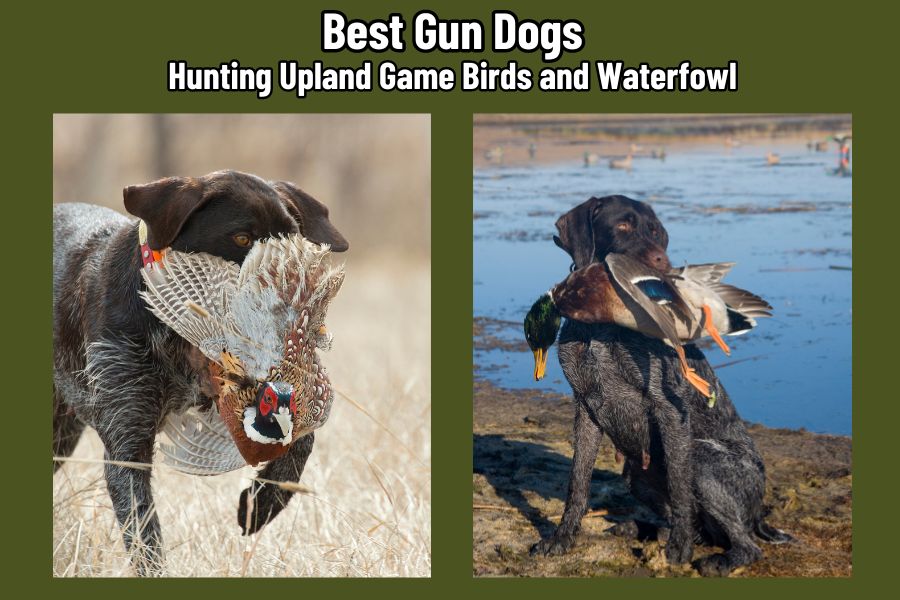Explore the world of the best gun dogs, including Retrievers, Pointers, Setters, and Spaniels. In this detailed guide you’ll discover each breed’s unique traits, roles in hunting, training techniques, care and maintenance and bonding with your gun dog. All of this and much more to help you choose the best gun dog for upland and waterfowl hunting.
Introduction
Imagine standing in the heart of a crisp and misty dawn as your loyal dog quivers with anticipation at your side. Each breed of the best gun dogs plays a pivotal role in the age-old sport of hunting. From the vast marshlands to the silent forests, gun dogs have been and still are essential partners in the hunt.
The history of gun dogs is as rich and varied as the landscapes they traverse. Bred over centuries for specific tasks, these dogs have evolved into the highly specialized breeds we know today—Retrievers, Pointers, Setters, and Spaniels—each having a distinct role in the hunt. What truly sets gun dogs apart is their unparalleled commitment and instinctive prowess, making each hunt not just effective, but a seamless work of collaboration.
Gun dogs are not only the best hunting dogs, they can become a cherished member of your family. So, let’s begin this journey together and explore the dynamic world of gun dogs.
The Four Pillars of Gun Dogs
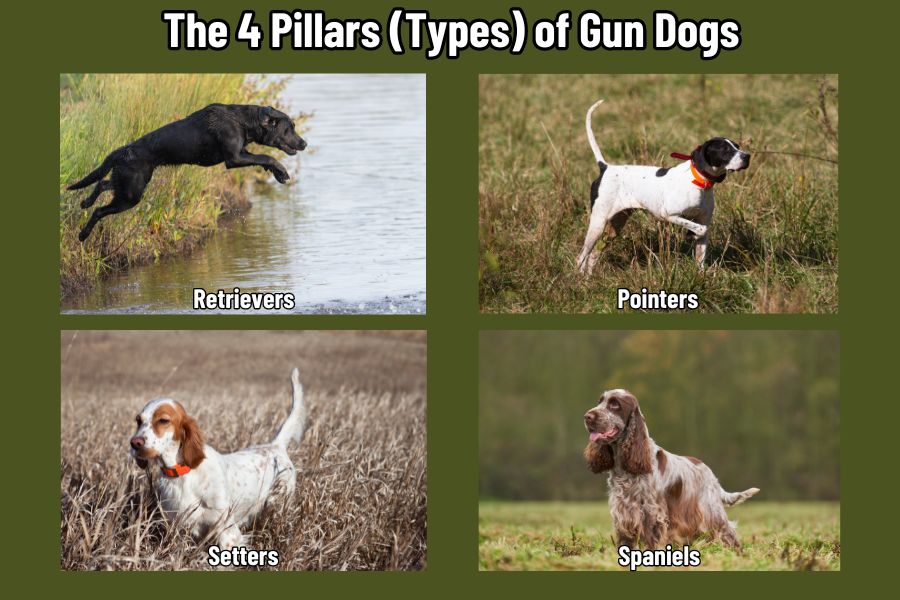
In the realm of hunting, the best gun dogs are not merely companions; they are foundational to the hunter’s success. This diverse group comprises four pillars or main types—Retrievers, Pointers, Setters, and Spaniels—each bringing unique skills and traits that have been honed through generations of breeding and training. Their contributions are invaluable, transforming the hunt from a mere pursuit into an art form.
Retrievers: The Loyal Companions
Among the Best Gun Dogs, retriever dogs hold a special place. Known for their remarkable ability to retrieve game from land and water, these retriever hunting dogs are a hunter’s best friend. They are particularly favored for their soft mouth—the ability to retrieve game without damaging it. This, coupled with their obedient nature and eagerness to please, makes Retrievers an indispensable part of the hunting team.
Did you know that the Labrador Retriever, a member of this group, has been the most popular dog breed in the United States for more than two decades? This fact alone speaks volumes about their versatility and enduring appeal.
Pointers: The Precision Specialists
Pointers, or pointing dogs, are the aristocrats of the hunting dog world. With their innate ability to locate and point to game, they allow hunters to prepare for the shot. Pointers stand still, directing their nose towards the game, providing an unmistakable signal.
This breed’s intense focus and energy make them superb hunters in open terrains where game birds are abundant. A lesser-known trivia about Pointers is their origin story, which dates back to 16th century Europe, where they were first trained to find hares and later adapted to bird hunting.
Setters: The Elegant Hunters
Setter hunting dogs are renowned for their grace and elegance, but their beauty is matched by their practical skills in the field. Setters are known for their “setting” behavior, where they locate game and then crouch low to the ground, unlike Pointers who stand. This method was particularly useful in earlier centuries, before the rise of shotguns, as it allowed hunters to throw nets over the game.
Today, Setters continue to be celebrated for their methodical searching and gentle demeanor, making them a favorite among those who appreciate a blend of tradition and functionality in their hunting practices.
Spaniels: The Tenacious Flushers
Lastly, spaniel hunting dogs are the enthusiastic flushers of the gun dog world. Known for their ability to work in dense underbrush, Spaniels excel at flushing game from difficult hiding spots, driving birds into the open where hunters can take a clear shot. Their compact size and boundless energy make them ideal for hunting in thickets where larger dogs might struggle.
An interesting note on Spaniels is their historical division into land and water types, with each subtype being perfected to master its terrain, showcasing the breed’s adaptability and versatility flushing game and retrieving as water dogs.
As we explore each of these remarkable breeds in more depth, you’ll gain insights into how to harness their hunting strengths ensuring a partnership that enhances both your experience and success in the field.
How to Choose the Best Gun Dog for Your Needs?

Selecting the best gun dogs for hunting isn’t just about preference—it’s about understanding the synergy between a hunter’s needs and the dog’s natural instincts. This decision is critical, as each breed brings its own set of skills and traits that can either enhance or hinder the hunting experience. Let’s explore how to align these dynamic elements, ensuring your choice not only complements your hunting style but elevates it.
Selecting the Right Gun Dog
When considering various gun dog breeds, it’s essential to weigh several key factors. First, assess the breed’s energy level and temperament to ensure it matches your hunting pace and patience.
Secondly, consider the dog’s size and coat, especially if you hunt in rough or variable climates; this can greatly affect the dog’s comfort and performance.
Lastly, think about the breed’s training receptivity. Some breeds, like the intelligent Labrador Retriever, might train easier than others, making them ideal for novice handlers. It’s about finding that perfect match that feels like an extension of your own hunting spirit.
Comparative Analysis: Retrievers vs. Pointers vs. Setters vs. Spaniels
The best gun dogs excel in different hunting scenario, making it crucial to match the breed to the specific game and terrain. Here’s how:
- Retrievers: Renowned for their ability to retrieve game from both water and land, Retrievers are best suited for waterfowl hunting. Their water-resistant coat and strong swimming ability make them ideal for lakes and marshy areas.
- Pointers: Known for their sharp, precise pointing abilities, Pointers are excellent for upland game hunting. Their stamina and speed make them well-suited for open fields and rolling terrains where game birds are plentiful.
- Setters: With their elegant search and subtle set, Setters thrive in upland game hunting, particularly in dense cover or wooded areas. Their methodical pace and keen sense of smell make them perfect for flushing out game while providing the hunter with ample preparation for the shot.
- Spaniels: Spaniels are vigorous and agile, making them exceptional at flushing game from thick underbrush and retrieving as water dogs. Their tenacity and energy are perfect for hunting in dense foliage or uneven terrains, where their compact size allows them to navigate easily.
Understanding these sporting dogs, their strengths and preferred scenarios will help you choose the right dog for your specific needs. This selection process will also help ensure that each hunting trip is productive, enjoyable, and tailored to the unique qualities of your chosen gun dog.
Training Your Gun Dog
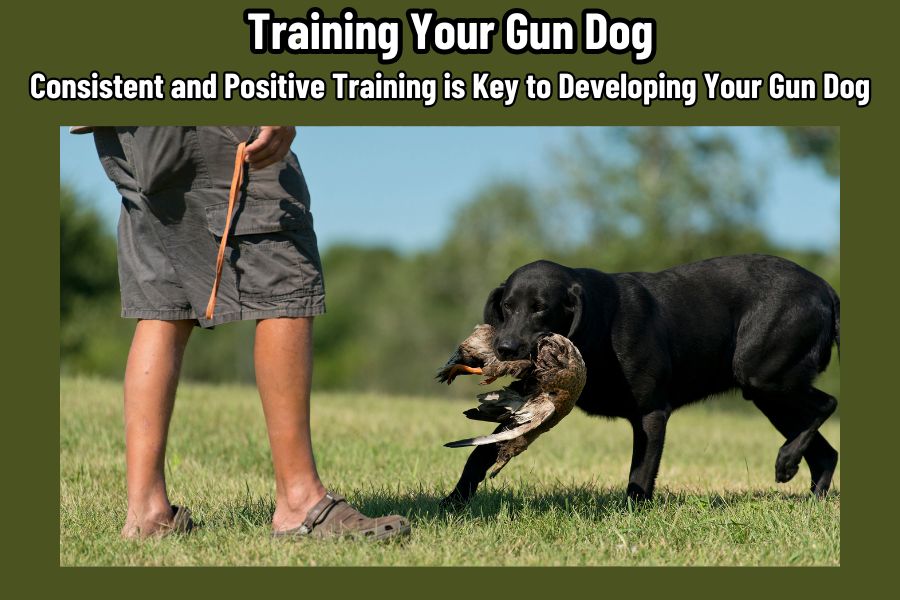
Training for the best gun dogs is more than teaching commands; it’s about cultivating a deep understanding and respect between hunter and dog. This section will guide you through fundamental training principles applicable to all gun dogs, as well as specialized techniques tailored to each breed’s specific talents and roles in hunting.
Retrievers: The Fetching Masters
Retrievers are naturally inclined to fetch, but refining this skill into a reliable hunting tool requires focused training. Start with basic fetch games to build enthusiasm, then gradually introduce training dummies that mimic game in weight and texture.
For advanced retrieval, incorporate scenarios that simulate actual hunting conditions, such as fetching from water or navigating obstacles. This not only sharpens their skills but also reinforces their natural retrieval instincts. Remember, consistent praise and reward are crucial in ensuring that these exercises remain enjoyable and engaging for the dog.
Pointers: Honing the Point
Pointers are celebrated for their precision and the iconic stance they take when spotting game. To hone this instinct, begin training in a controlled environment with minimal distractions. Use a wing on a string to stimulate their interest and trigger their pointing instinct, gradually introducing the command to “point” as they exhibit the desired behavior.
As their skills advance, practice in more complex environments that mimic real hunting conditions to ensure their focus and obedience are maintained. This training not only perfects their pointing but also enhances their overall field performance.
Setters: Perfecting the Set
Setters require a gentle approach to training, focusing on patience and precision. These dogs are natural at setting, which involves locating game and then adopting a low, stealthy stance. Early training should encourage these behaviors with positive reinforcement, using scent trails to develop their tracking abilities.
Advanced training should involve real-life scenarios, teaching them to maintain their set even in stimulating environments. This patience training is crucial for setters, as their ability to hold a set can be the difference between a successful hunt and a startled game.
Spaniels: Flush and Retrieve
Training Spaniels involves a delicate balance between their natural flushing and retrieving instincts. Start with basic retrieval exercises to build their confidence and responsiveness to commands. As they progress, introduce controlled flushing scenarios where they must flush out game and then retrieve it under direction.
This dual training approach ensures that Spaniels can effectively switch between flushing and retrieving, making them versatile partners in the field. Incorporating challenges such as varied terrain and cover types can further enhance their adaptability and skill.
Through dedicated and thoughtful training along with patience, the best gun dogs can reach their full potential much quicker than you might expect. Remember, consistent and positive gun dog training is key to developing a capable and trustworthy hunting companion.
Care and Maintenance of Your Gun Dog
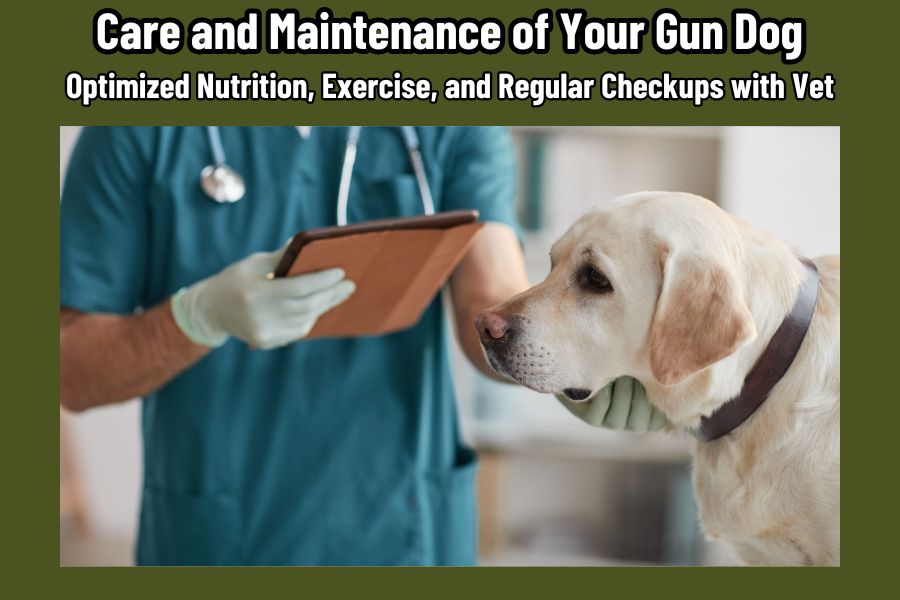
To keep the best gun dogs at their peak performance isn’t just about proper training; it’s equally crucial to focus on their care and maintenance. This section provides some key tips about nurturing your gun dog’s health and well-being through optimized nutrition, regular exercise, and essential healthcare practices.
Nutritional Needs for a Healthy, Active Gun Dog
The right diet fuels your gun dog’s energy and health, enabling them to perform at their best during hunts. High-quality proteins are vital for muscle repair and growth, while fats provide sustained energy—critical for the long hours spent in the field. Don’t overlook the importance of vitamins and minerals which support bone health, digestion, and overall metabolic functions.
Tailoring the diet to your dog’s specific age, breed, and activity level is crucial; puppies, for example, require more calories and protein per pound of body weight compared to adult dogs. It’s also beneficial to discuss your gun dog diet with a vet to ensure it optimizes oxygen metabolism for increased endurance, especially considering the physical demands placed on a working gun dog.
Exercise Regimens and Health Care Essentials
Regular exercise is not just a part of training but a cornerstone of maintaining your gun dog’s health. Adequate physical activity ensures your gun dog maintains a healthy weight, which can prevent a myriad of health issues, such as joint problems and cardiovascular diseases. Exercise routines should be varied and could include running, swimming, and agility training, which not only keep them fit but also sharpen their hunting skills.
In terms of healthcare, regular veterinary check-ups are essential to monitor their overall health and to keep up-to-date with vaccinations and parasite control. Special attention should be given to their ears and paws, which can become breeding grounds for bacteria if not cleaned regularly, especially after hunting in wet or muddy conditions.
Implementing a well-rounded care regime will extend your gun dog’s active years and enhance their quality of life. This proactive approach to health and wellness is just as important as their field training, ensuring they remain capable and enthusiastic hunting partners as long as their age permits.
The Hunter-Gun Dog Bond
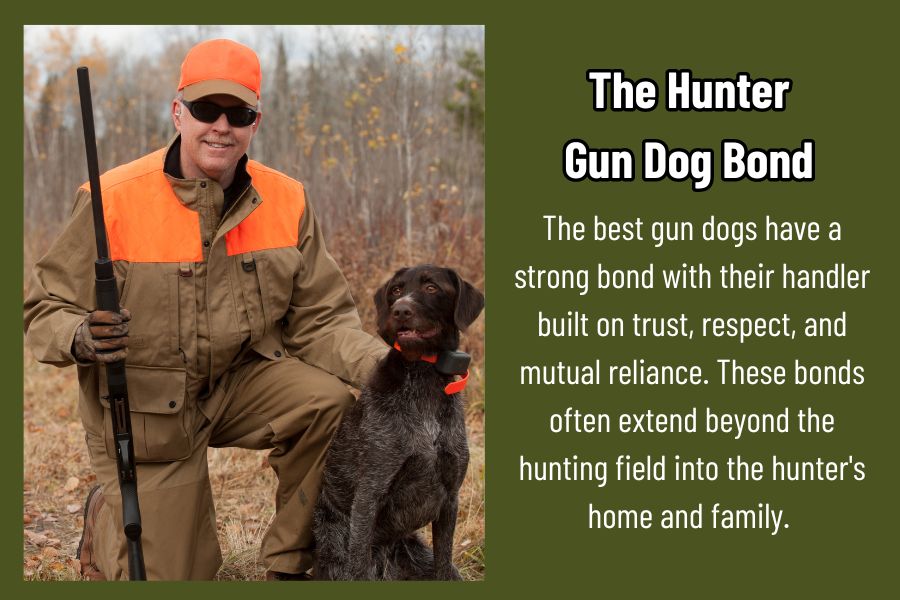
The best gun dogs have a strong bond with their handler built on trust, respect, and mutual reliance. This deep connection is what makes a good hunting dog not just a tool but a beloved partner in the field.
The Special Relationship Between Hunter and Gun Dog
A hunter and their gun dog develop a language of their own, a silent communication through gestures and looks that dictate their actions in the field. This rapport is nurtured through shared experiences and challenges, with each hunt strengthening the ties between them.
The trust a gun dog has in its handler is a clear reflection of the care and respect it receives. This symbiotic relationship not only increases the success rate in hunting but also contributes to the overall satisfaction and joy of each hunting trip.
Interesting Stories About Gun Dogs and Their Impact
Throughout history, there have been countless tales of gun dogs whose abilities and loyalty have left an indelible mark on their handlers and the hunting community. For instance, consider the story of “Old Drum,” an American Black and Tan Coonhound known in the 19th century. Old Drum’s tragic death led to a landmark court case that famously coined the phrase “man’s best friend,” highlighting the deep emotional connections humans have formed with their hunting dogs.
Another inspiring story is that of a Labrador Retriever named Endal, who saved his handler’s life by pulling him into the recovery position, covering him with a blanket, and fetching help when he was knocked unconscious. Endal was awarded numerous honors for his intelligence and dedication, demonstrating the capabilities and profound impact of gun dogs beyond the hunting fields.
These stories and others like them not only underline the capabilities of gun dogs but also illustrate the profound emotional bonds that can form between hunter and dog. These bonds often extend beyond the hunting field into the hunter’s home and family. This section of the narrative serves to remind us why the best gun dogs are so revered and how they enrich the lives of those who train and hunt with them.
Closing Reflections on Our Gun Dog Companions
As we conclude our exploration about the best gun dogs, it’s clear that these faithful companions are much more than just participants in hunting—they are integral to the heritage and tradition of the sport. The roles they play, from the keen-eyed Pointers to the steadfast Retrievers, highlight their indispensability and the evolution of hunting practices over centuries.
The best gun dogs embody the spirit of hunting, merging skill, loyalty, and an innate connection with their handlers to create a seamless hunting experience. They are not just animals trained for a purpose but are partners that enrich the hunting experience with their character and capabilities. Whether you’re a seasoned hunter or just beginning to explore the world of hunting with a canine partner, the value of investing in a good gun dog is immeasurable.
The best gun dogs do more than help hunters find game; they carry forward a lineage of hunting tradition, embodying the essence of the partnership between hunter and dog.
FAQs: Best Gun Dogs
Where did the Gun Dog come from?
Best Gun Dogs Answer:
Gun dogs, also known as sporting dogs, originated in various parts of Europe and the United Kingdom several centuries ago. These breeds were developed to assist hunters in finding, flushing, retrieving, and pointing game. Different breeds were developed for specific tasks and terrain, shaping their evolution according to the hunting needs of the time.
What is a started gun dog?
Best Gun Dogs Answer:
A started gun dog is a young dog that has begun its training in hunting but is not yet fully trained. Started dogs typically know basic obedience commands, have been introduced to gunfire, and understand the fundamentals of retrieving or pointing. They are ideal for hunters who wish to continue training the dog themselves but want to skip the earliest stages of training.
What is a finished Gundog?
Best Gun Dogs Answer:
A finished gun dog is one that has completed all aspects of its training and can perform in the field as a fully reliable hunting partner. These dogs respond well to commands, handle all types of game and terrain adeptly, and have been trained to work with distractions and in various hunting scenarios. Finished dogs are ready to participate effectively in hunts and often in competitive field trials.
What makes a dog a retriever?
Best Gun Dogs Answer:
A dog is classified as a retriever based on its ability to go out, collect game, and bring it back to the hunter without damage. Retrievers have soft mouths, meaning they can carry game gently without puncturing it. They are also known as water dogs for their love of water, making them ideal for retrieving game from lakes and rivers.
What are pointer dogs good for?
Best Gun Dogs Answer:
Pointer dogs are prized for their ability to locate game birds and maintain a fixed position (point) to direct the hunter to the bird’s location. This capability makes them invaluable for upland game hunting where precision and a delicate approach to the game are crucial. Their stamina and focus allow hunters to cover large areas efficiently.
What are the four breeds of Setters?
Best Gun Dogs Answer:
The four main breeds of Setters are the English Setter, the Irish Setter, the Gordon Setter, and the Irish Red and White Setter. Each breed has distinct characteristics and coloring but shares a common skill set in locating and “setting” upon game, which involves crouching near the game to signal its location to the hunter.
Which spaniel is best for hunting?
Best Gun Dogs Answer:
The choice of the best spaniel for hunting can vary based on the type of hunting and the terrain. However, the English Springer Spaniel is widely regarded as one of the most versatile and capable hunting spaniels. Known for its ability to flush and retrieve game in dense cover, the Springer is enthusiastic, enduring, and has a keen sense of smell, making it ideal for both upland game and waterfowl hunting.
Resources: Best Gun Dogs
These resources provide comprehensive insights and training methodologies for anyone looking to deepen their understanding and skills about gun dogs and gun dog training.
SPECIAL NOTE: “The information provided in this post about best gun dogs is based on research using the Resource links listed below. While we try to keep the information for this post current, there are no representations expressed or implied, about the completeness, or accuracy of the information provided. Therefore all hunters should always verify current information from these resources along with other local and federal publications”.
Online Resources
- American Kennel Club (AKC) – Sporting Group
- The Kennel Club (TKC) – Search Breeds A-Z
- United Kennel Club (UKC) – Hunting OPS
- Canadian Kennel Club (CKC) – Sporting Dogs
- Gun Dog Journal Magazine – Gun Dog Breeds
Books
- Richard A. Wolters, Gun Dog: Revolutionary Rapid Training Method
- Ben O. Williams, Bird Dog: The Instinctive Training Method
- Tom Dokken, Tom Dokken’s Retriever Training: The Complete Guide to Developing Your Hunting Dog
Check out our blog posts about hunting with dogs in…
Alabama
Alaska
Arizona
Arkansas
California
Colorado
Connecticut
Delaware
Florida
Georgia

